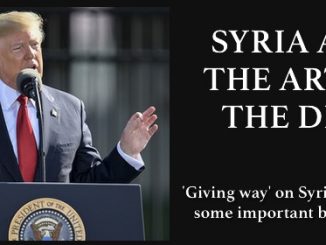
ER Editor: A strong and vital OPEC+ partnership between Russia and Saudi Arabia is about to extend into full BRICS membership for Saudi Arabia, as they seek to cut back further on oil production to stabilize the global oil market and raise prices. This is M.K. Bhadrakumar‘s article below.
Washington’s reaction to all of this? A warning from ‘Biden’ of ‘consequences’ for this oil production cut according to a WaPo leak, with MBS vowing his own retaliation (see Saudi Crown Prince Threatened to Damage US Economy):
The Biden administration had said it would re-evaluate relations with the kingdom following a decision by Riyadh to slash crude production against the wishes of the US.
The Crown Prince, who is widely referred to as MBS, warned that he would not deal with the US administration anymore if Biden penalized Saudi Arabia. He also promised “major economic consequences for Washington,” the Post reported on Thursday.
The threat was contained in a classified document that was leaked on a Discord server, but it was not clear whether the remark was part of intercepted communications or a message sent privately to the US.
********
Saudi-Russian Concord is the Secret Behind OPEC+
M.K. BHADRAKUMAR via COVERT GEOPOLITICS
Behind the raft of OPEC+ production decisions riling the collective west lies a tight Russian-Saudi strategy and enhanced Russian-Iranian energy cooperation.
A curious thing happened in Vienna on Sunday (ER: June 4th) just as the 35th Ministerial Meeting of OPEC+ was about to start at its headquarters. Three princely western news organizations – Bloomberg, Reuters, and the Wall Street Journal – were barred from entering the OPEC premises. When asked about it, pat came the reply: “This is our house.”
Indeed, OPEC officials were left with no option other than an unorthodox way of “mood setting,” given their heightened sensitivity about the wild stories disseminated in the western media about disagreements between Saudi Arabia and Russia, the two high flyers in OPEC+.
To be sure, OPEC+ touches raw nerves in Washington even seven years after the group took shape as the brainwave of Russian President Vladimir Putin and Saudi Crown Prince Mohammed bin Salman (MbS). The two leaders intended that they would have more control over the global crude oil market.
The impetus to realism on the part of Moscow and Riyadh has only grown since 2016, and will crystalize further after the US-led G7 inserted itself into rule making in the world oil market last year, threatening to fragment the entire ecosystem.
Saudi Arabia’s BRICS aspirations
Neither Russia nor Saudi Arabia can afford a break-up of OPEC+. In fact, had there been no OPEC+ today, there would be an urgent need to create one, as both Moscow and Riyadh have, in different ways, come under US pressure on account of their global pre-eminence as energy producers.
Their potential to be key players in the emerging multipolar world is giving Washington the jitters. Saudi Arabia has formally applied for BRICS membership and sought to join the New Development Bank, the multilateral development bank established by the BRICS states and headquartered in Shanghai, China.
In fact, Saudi Foreign Minister Prince Faisal bin Farhan Al-Saud was present in Cape Town last week for the BRICS ministerial meeting. On the sidelines, Bin Farhan met Russian Foreign Minister Sergey Lavrov. The Russian readout underscored the depth and profundity of the current level of relations between the two countries.
Saudi Arabia is tiptoeing toward BRICS at a historic juncture when the group is reportedly all set to create its own currency at its forthcoming summit in Durban, South Africa. This, of course, will be a calamitous development for the petrodollar – the pillar of the western banking system – and holds the potential to create a new global oil market.
Russia-Iran oil cooperation
To digress a bit, on 18 May, Russia and Iran signed 10 documents for cooperation in the oil industry, comprising six memorandums of understanding, two contracts, one agreement, and a roadmap related to bilateral cooperation in the fields of industry, transfer of technology, and oil recovery enhancement.
These agreements allow Russia (together with China in separate agreements) to have its companies present in any oil and gas field in Iran that Moscow chooses. Following the signing ceremony in Tehran, the visiting Russian Deputy Prime Minister Alexander Novak, who is also the co-chair of the Permanent Russian-Iranian Commission on Trade and Economic Cooperation, stated that the two countries held negotiations on banking interactions and using their national currencies in the bilateral transactions.
Quite obviously, Iran’s strategic ties with Russia is a spectre that haunts the administration of US President Joe Biden. In that context, Saudi Arabia’s gravitation toward BRICS adds to the angst in the western mind. It is hardly surprising that feverish US attempts are afoot to undermine OPEC+.
Agreement on oil production cuts
No sooner than the OPEC+ ministerial at Vienna ended, Deputy PM Novak made clear that Russia and Saudi Arabia were in lockstep on the OPEC+ deals:
“No, there were no [Russian-Saudi] differences. We always find common solutions. For years, our agreements have been in force in the interests of the market, in the interests of the countries participating in the agreement, and in the interests of both exporters and producers. We always find common solutions with Saudi Arabia. Naturally, we always have preliminary discussions, but nevertheless we always reach concord.”
In Moscow on Monday, Kremlin spokesman Dmitry Peskov told reporters: “The Russian Federation is a member of the joint understanding (in Vienna). The OPEC+ format continues its work, there are common agreements that, of course, everyone will follow. Of course, this format retains its importance and its significance for ensuring stability in international energy markets.”
The decisions taken by the OPEC+ ministerial after seven hours of talks amply bears out the Saudi-Russian “concord”: An agreement on pegging the 2024 baselines at 40.46 million barrels a day, against which the production cuts are to be measured; reduction of overall production targets from 2024 by a further 1.4 million bpd in total; the deep cut by Saudi Arabia to its output in July on top of a broader OPEC+ deal to limit supply into 2024 as the group seeks to boost flagging oil prices; Russia’s extension of its voluntary oil production cut by 500,000 barrels daily till end-December 2024, which will be calculated from the 2024 quota, which in turn has now been reduced to 9.828 million barrels a day as part of the deal.
OPEC+ seeks ‘stability and market balance’
Novak told Russian TV on Sunday that OPEC Plus nations have taken “an important decision to extend the voluntary cuts announced by the countries from 1 May, 2023 in order to balance the market. This is 1.66 million barrels a day on top of what was announced last October … So, in aggregate terms, it is 3.66 million barrels undertaken by the OPEC+ countries to ensure stable market operation.” He continued:
“The agreement is in force until the end of 2023, that is why we discussed the issue of its possible extension until the end of 2024 for quite a long time today. Two major decisions have been passed: first, to extend the existing agreement until the end of 2024, and, second, to extend throughout 2024 voluntary cuts by 1.66 million barrels a day starting 1st May undertaken by nine countries.”
“This will make it possible to have long-term forecasts of the effect of our agreement for 18 months ahead. These are key decisions we discussed and passed today… Naturally, we have possibilities to adjust our decisions. If necessary, we will do so to ensure the market stability so that it is balanced and clear for investors, buyers, and exporters. For all market players.”
Indeed, as the Saudis have sought, oil prices rose on Monday, with global benchmark Brent oil climbing toward $78 a barrel. On the whole, if there has been any “winner” in the OPEC+ talks on Sunday, it must be the UAE, which gets a boost to its production limit for next year at the expense of some African members who were asked to give up part of their unused quotas.
The finely balanced OPEC+ decisions “to achieve and sustain a stable oil market, to provide long-term guidance for the market, in line with the successful approach of being precautious, proactive, and pre-emptive,” – to borrow from the OPEC press release on Sunday – have only been possible due to the trust and mutual confidence among the key players within the group, Russia and Saudi Arabia, in particular.
************
Source
Featured image source, Biden: https://www.gop.gov/news/documentsingle.aspx?DocumentID=390

••••
The Liberty Beacon Project is now expanding at a near exponential rate, and for this we are grateful and excited! But we must also be practical. For 7 years we have not asked for any donations, and have built this project with our own funds as we grew. We are now experiencing ever increasing growing pains due to the large number of websites and projects we represent. So we have just installed donation buttons on our websites and ask that you consider this when you visit them. Nothing is too small. We thank you for all your support and your considerations … (TLB)
••••
Comment Policy: As a privately owned web site, we reserve the right to remove comments that contain spam, advertising, vulgarity, threats of violence, racism, or personal/abusive attacks on other users. This also applies to trolling, the use of more than one alias, or just intentional mischief. Enforcement of this policy is at the discretion of this websites administrators. Repeat offenders may be blocked or permanently banned without prior warning.
••••
Disclaimer: TLB websites contain copyrighted material the use of which has not always been specifically authorized by the copyright owner. We are making such material available to our readers under the provisions of “fair use” in an effort to advance a better understanding of political, health, economic and social issues. The material on this site is distributed without profit to those who have expressed a prior interest in receiving it for research and educational purposes. If you wish to use copyrighted material for purposes other than “fair use” you must request permission from the copyright owner.
••••
Disclaimer: The information and opinions shared are for informational purposes only including, but not limited to, text, graphics, images and other material are not intended as medical advice or instruction. Nothing mentioned is intended to be a substitute for professional medical advice, diagnosis or treatment.





Leave a Reply